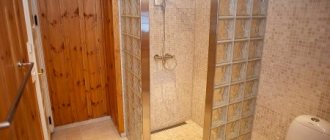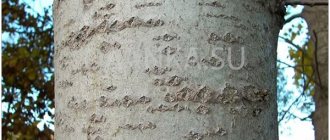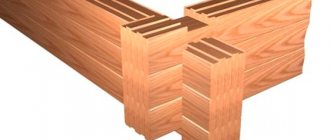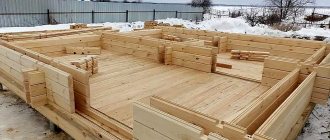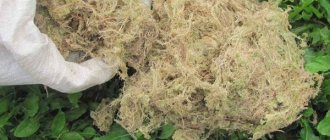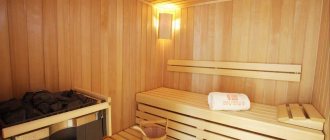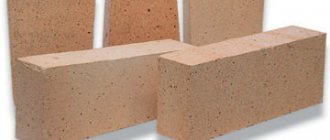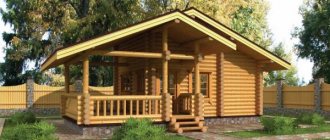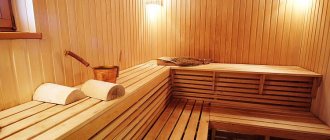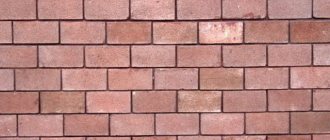When constructing a building or its individual parts, the developer often faces the concept of dew point.
This term has been heard by everyone who has ever replaced windows, insulated walls or changed the heating system in their home.
So, let's look at what a dew point is, why you need to know its location in the wall and how it can be determined using available means.
Role in the construction process
If the dew point turns out to be too high, then building materials such as cement, wood, metal and others will not produce the desired effect in the building and, even worse, will not last long. And if condensation forms on the surface of polymer materials during laying, this can cause the following defects:
- surface swelling;
- detachment;
- shagreen.
It is unlikely that it will be possible to visually calculate the dew point in the wall, since this will require a table of the corresponding indicators and a non-contact thermometer (we will talk about this procedure in the section “Determining the dew point and making calculations”).
What can influence this value?
There are several things that can affect this:
- wall thickness, as well as building materials used for insulation;
- humidity (when there is a high concentration of moisture, the dew point rises);
- temperature - it varies greatly and depends on the specific area.
To get a more detailed look at the process, let's look at several common situations.
- If the wall is not insulated, the dew point will begin to fluctuate under the influence of climatic conditions. If the weather is stable, the point will move closer to the outer wall. In this case, the house itself will not be damaged. And if it gets colder sharply, then this point will shift to the inner wall. The room will become saturated with condensation, and the walls will slowly become wet.
- If the wall is insulated from the inside, then the dew point will be located somewhere in the center between it and the insulation. With high humidity, this is hardly the best option, since after a sudden cold snap the point will move closer to the junction with the insulation, which can have a destructive effect on the structure. Note that in a humid climate, insulation from the inside is possible only with an efficient heating system capable of providing the same temperature conditions in all rooms.
- In the case of external wall insulation, the dew point will move inside the insulating layer. When purchasing material for thermal insulation, you need to take this point into account and correctly determine the required thickness.
Note! If climatic conditions were not taken into account during repair work, then if troubles arise, it will be very difficult, almost impossible, to eliminate them. All that remains is to undo everything that has been done and start again (read: additional costs).
Internally insulated wall
A wall insulated from the inside is “fenced off” from the heat that reigns inside the room. Here the dew point moves towards the inside of the wall. As a result, the temperature value under the thermal insulation material decreases. That is, “our heroine” occupies a location where the occurrence of condensation, alas, is almost inevitable.
Next, we look by analogy with the previous options:
- in the thickness of the wall - the structure is dry, but it can get wet with a sharp temperature change (it moves towards the inner surface - into the room);
- on the inner plane of the wall under the heat-insulating material - the structure can be wet throughout the harsh period;
- inside the thermal insulation material - the wall and insulation can be wet all winter.
We determine the dew point and make calculations
We all want to live comfortably, but this is unlikely to be possible in conditions of high humidity. Condensation is harmful not only to the home (particularly to the walls), but also to human health (the risk of asthma increases). Moreover, if the humidity is high, then the walls and ceiling can become covered with mold, which is so harmful to the body and so difficult to remove. Often you even have to change all the finishing coatings to get rid of harmful microorganisms.
And in order to avoid all these troubles, we recommend calculating the dew point in the wall and thereby finding out whether it is advisable in your case to begin repair work, carry out insulation, or even start building a new house. It is worth remembering that the concept of dew point is individual for each specific building, therefore, it has to be calculated differently each time. But before proceeding directly to the calculations, it is necessary to take into account the following factors:
- climatic features of your region;
- presence and frequency of powerful wind;
- wall thickness;
- building material used in construction.
Humidity, although within acceptable limits, is contained in almost every material. You must ensure that it does not rise and condensation does not appear. And even if you call a specialist in case of increased humidity levels, he will most likely say that you have incorrect thermal insulation, the thickness of the building materials is not appropriate, or an error was made during installation. This is partly true, because it is competently carried out repairs that largely influence the location of the dew point and the formation of condensation on the surface of the walls.
Table for calculating dew point
Note! For intermediate numbers that are not indicated in the table, it is necessary to determine the average value.
Calculating the dew point in a wall using a table - detailed instructions
First, take care of the necessary equipment. You will need:
- thermometer;
- a non-contact thermometer, which, by the way, can be replaced with a regular one;
- hygrometer.
Below is the algorithm of actions.
Step 1.
In the room where you need to determine the dew point, measure approximately 60 centimeters from the floor, no more. After this, determine the air temperature at a given altitude (to do this, you can put a thermometer, say, on a table).
Step 2.
Next, take a hygrometer and determine the humidity at the same point.
Step 3.
In the table we gave above, find your value and then find out the cherished dew point.
Step 4.
Then you should determine whether it is possible to carry out renovation work in a building with similar humidity - for example, pouring a polymer floor or laying thermal insulation. To this end, take a non-contact thermometer and measure the temperature of any surface at the same point 60 centimeters away. In the absence of this device, you can take a simple thermometer, wrap it in a rag and take readings in about fifteen minutes.
Step 5.
Finally, compare both numbers. If the surface is warmer than the air by more than 4? C, then the humidity is high and there is a possibility that the dew point is present. If so, then thermal insulation work should be supervised by an experienced specialist who will take into account the thickness of the building material that will be used for this.
Video - Determining dew point
How to use the results?
Now let's find out how we can use the results that the calculation of the dew point in the wall gave us. If you know where this point is located, you will be able to correctly determine the thickness of the insulation, thereby preventing condensation from appearing in the wrong place.
But perhaps you are interested in another, no less important question: when should insulation be carried out from the inside, and when from the outside? To answer it correctly, you should take into account those factors that can influence the dew point in one way or another. Here they are:
- climatic conditions;
- presence of insulation;
- permanent/temporary residence;
- indoor/outdoor humidity level;
- what a particular wall is adjacent to (another room or the street);
- indoor/outdoor temperature;
- efficiency of the ventilation system;
- the material from which the walls are built and its thickness;
- efficiency of the heating system.
Of course, there are a number of cases in which it is impossible to insulate walls. These are the cases:
- if they live in the house permanently;
- if the wall thickness is sufficient (in the conditions of a particular region), that is, the thermal insulation layer one way or another should be no thicker than 5 centimeters;
- if the ventilation system operates in accordance with all standards;
- if the heating system also works well.
Simply put, everything said above can be formulated as follows: the higher the temperature in the region, the better the ventilation and heating systems, the greater the likelihood that internal insulation will be used. Although the experience of many builders says that it is often better to insulate a building from the outside - this way the chances that the dew point will be in the required place will increase significantly.
External insulation
If the thermal insulation material is located outside (on the street side), then the position options are as follows:
- inside the thermal insulation raw material (we take into account the type of material, climate zone, required thickness) - the structure will be dry from the inside;
- in the case where the thermal insulation is thinner than it should be, all three methods used for an uninsulated surface (previously discussed) are appropriate.
What happens if you choose the wrong point?
The air leaving a heated room in winter will become supercooled and form condensation on all surfaces with a lower temperature. This is why the walls will be wet all the time, resulting in the appearance of harmful microorganisms and mold. And this, therefore, can cause asthma.
And the building itself will not last long - its destruction will significantly accelerate. Buildings with fungus and mold cannot last long. In this regard, the dew point should be correctly determined at the design stage. You must choose:
- material for construction;
- thermal insulation material;
- type of heating and ventilation systems;
- insulation technology.
Results
You can calculate the dew point on your own, the main thing is that the climatic conditions of the area are taken into account. If you are not confident in yourself, contact a specialized company - for a fee they will take measurements for you!
Dire consequences
Did you insulate the walls inside when it was impossible? My sincere congratulations - you are a truly Russian person who first acts and then thinks. Do you hope it will pass? No! Unfortunately, you will now have to face the following problems:
- wet walls;
- wet thermal insulation material;
- musty aroma;
- dampness;
- mold;
- fungus;
- rot;
- peeling of facing raw materials;
- destruction of structures - elements in a wooden house fall apart very quickly;
As you can see, the consequences are very serious. Therefore, when insulating walls, you cannot neglect the advice of specialists and turn on the “Russian” option. True, if you don’t want the saturated steam to turn into water, which will happily settle on all kinds of surfaces in your home.
